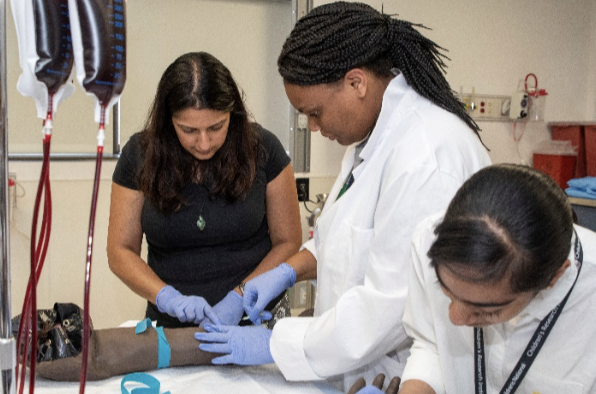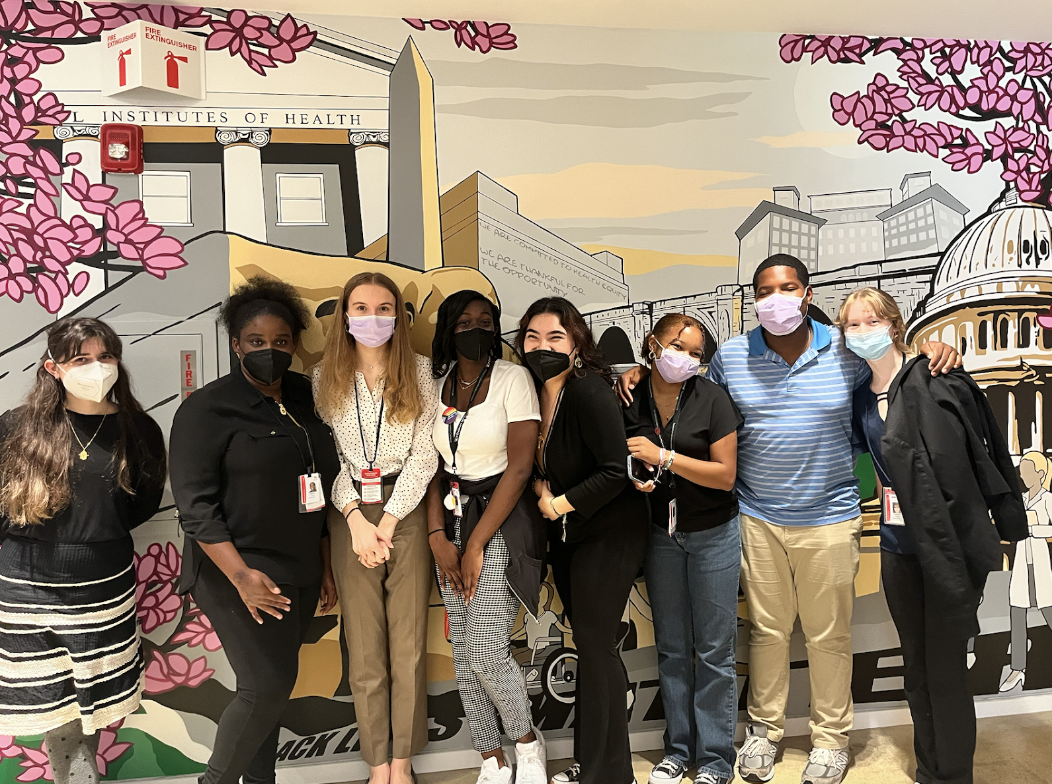Broadening the STEM and Health Pipelines
Promoting greater diversity in the biomedical research pipeline.
For decades, the United States has struggled to produce a sufficient number of scientific and medical professionals. This problem is often referred to as the "STEM pipeline crisis," and those attempting to solve it frequently point to one particularly leaky part of this pipeline: the period between highschool and college. For a whole host of reasons, many high school students with strong STEM interests and aptitudes find it difficult to earn the advanced degrees required for employment in scientific and biomedical occupations. This is particularly true for historically and persistently excluded groups, who confront numerous obstacles to entering the STEM pipeline, and who are severely underrepresented in STEM and biomedical occupations.
Fortunately, there are ways to solve this problem. Recent research indicates that one way to help these students achieve their STEM or health-related career ambitions is through pre-college outreach programs—essentially, short-term educational experiences during high school (like internships or summer programs) that support skills development and help youth advance toward their STEM or health-related occupational goals.
METEOR was designed to do just that. Formally known as "Mentored Experience to Expand Opportunities in Research version High School," METEOR was launched in 2017 by the Children's National Research Institute (CNRI) at Children's National Hospital (CNH). With funding from the National Institutes of Health (NIH), and through partnerships with the George Washington University Graduate School of Education and Human Development and the DC Public and Public Charter High School (DCPS) system, METEOR has two main goals:
- To support diverse students on their pathways to college and careers in biomedical sciences.
- To build teachers' capacity to translate laboratory practices and techniques into actionable classroom improvements.
Between 2017 and 2022, METEOR gave high school students and teachers throughout the Washington, DC metropolitan area (whose school districts serve many students from historically and persistently excluded groups) the opportunity to learn about and contribute to biomedical research at Children's National Hospital. It consisted of two separate six-week summer programs: one for students, and one for teachers.
METEOR for Students
Over the course of the project's six-year history, a total of 47 students participated in METEOR. Eighty-five percent of these students self-identified as a person of color, and 75% were female. Participants were matched with mentors from more than 10 divisions at CNH and CNRI, including Bioengineering/Biotechnology, Cardiology, Endocrinology, Emergency Medicine, Oncology, Otolaryngology, Neonatology, Nursing Quality and Safety, and Trauma and Burn Surgery. Working with their mentors, students developed and completed a hypothesis-generating project that included data collection, statistical analysis, and a presentation made to senior hospital leadership. To gain a feel for what it's like to be a practicing biomedical researcher, students also took tours of the hospital, including to Laboratory Medicine, Anatomic Pathology (brain dissection), Radiology (MRI, CT), and Bioengineering. During sessions in the Simulation Lab at George Washington University's CLASS Center, they learned how to ascertain blood pressure, draw blood, and perform intubations.

In addition to working with practicing scientists on a day-to-day basis within Children's National Hospital, students also went on field trips to a variety of biomedical institutions—including the National Institutes of Health (NIH) Clinical Center, the National Library of Medicine, various FDA pharmacogenetics laboratories, the veterinary hospital at the Smithsonian National Zoo, and the National Museum of Health and Medicine. Students even traveled to Capitol Hill to observe a Senate health policy discussion! Each of these opportunities connected learning with real-world applications, helping students understand what it means to be a professional scientist on a day-to-day basis.
Across METEOR's six-year history, Knology learned about participating students' experiences and perceptions through a combination of evaluative instruments—including surveys, interviews, and journal entries. As their assessment showed, student feedback on METEOR was overwhelmingly positive. Students described the project with statements like "one of the peaks of my high school career" and "I loved every part of the internship." In addition to capturing their enthusiasm for METEOR, our evaluation also showed that the project increased students' knowledge of different STEM and health-related career paths and equipped them with some of the skills required for success in different scientific and biomedical fields. Expressing a common sentiment, one student applauded METEOR for teaching them that "there's so much more to medicine and the professional realms around it" than they had previously realized.
Students also credited METEOR with making them feel more like "science people"—that is, like they belong to the world of professional biomedical science. As one student explained:
Before METEOR, I had no self-esteem that I would even get into a program whatsoever. So, when METEOR went ahead and accepted me, I was so surprised... And so, it definitely empowered me into finding different opportunities... And it empowered me so much to where I now feel competent in my ability to apply to different programs.
As this statement reveals, METEOR was an incredibly empowering experience for students. In a survey Knology administered, 23 of 28 student respondents said that METEOR had enhanced their interest in pursuing a STEM career. One student reflected that "my view of myself has changed in that now I feel I could be a scientist and [it] is more enjoyable than I imagined." Most agreed that METEOR made them more confident of their prospects for success as scientific and biomedical professionals. Students spoke of METEOR as something that "really proved to me my potential" and "empowered me into finding different opportunities."

As data from Knology's evaluation shows, METEOR succeeded in broadening the STEM and biomedical pipelines. The follow-up data we collected each year confirms this. After completing the summer experience, 11 students continued their research through the school year, including seven from the 2022 cohort who are continuing their projects currently. To date, 100% of METEOR alumni have graduated high school. Of the total population of DCPS students, only 69% Black/African American and 77% of females graduated from high school in 2021. By contrast, 80% of METEOR alumni are attending college and more than half are majoring or minoring in a STEM field.
METEOR for Teachers
Between 2017 and 2022, 8 teachers participated in METEOR. These teachers matriculated at the George Washington University (GW) Graduate School of Education and Human Development (GSEHD) in pursuit of a Graduate Certificate in STEM Teaching. In these classes, they developed skills in translating scientific practices into lesson plans and curricula for their classrooms.
Through their coursework at GSEHD, the teachers developed an advanced understanding of professional practice-based inquiry methods including 5E, Argument Driven Inquiry, and Engineering Design Challenges. All the teachers used these methods to develop lessons and unit concepts based on their research experience and implemented them in their classrooms. This translation from laboratory to classroom is evidence of METEOR's potential to impact a wider audience than just those who participate, with high school students in those classrooms also benefiting from high quality teaching practices. The program also forges deeper bonds and connections among METEOR teachers and students that continue through the school year.
Knology's evaluation showed that METEOR helped teachers incorporate new research methodologies and practices into the classroom, gave them techniques for more effectively promoting students' access to STEM and health-related careers, and taught them how to build more inclusive STEM learning environments. Many teachers discovered new strategies for helping Black and African American students overcome racial barriers to STEM access, and for dealing with phenomena like imposter syndrome.
Along with this, teachers applauded METEOR for giving them a language to talk about the many different kinds of careers that exist within STEM and health fields. Drawing attention to how METEOR facilitated uptake of a "STEM for all" mentality, one teacher noted how prior to participating in the project, they had "pushed every kid into doing a traditional bench science project with, you know, an experiment and a hypothesis." Having previously referred to social sciences as "soft," METEOR completely changed their mind. "That's one of the things that I learned this summer, is that in the real world there is no soft science."
Teachers also applauded METEOR for giving them a deeper understanding of the different kinds of careers their students could pursue. Many came away even more committed to helping them gain access to the STEM and healthcare fields. As one teacher put it,
After this METEOR experience, I have a broader appreciation and viewpoint of the different science careers that are out there. And as I have the students that are doing these social science projects, I'll be able to better funnel them towards potential careers related to that.
Let's Put it to Work!
METEOR's key goals were to help students advance toward STEM and biomedical careers, and to help teachers become better STEM educators in the classroom. Our evaluation showed that the project succeeded on both of these fronts. METEOR not only made students more knowledgeable, but also strengthened their science identities and promoted confidence in their prospects for success as STEM and health professionals. It also helped teachers expand their curricula, create more diverse learning environments, and discover new ways to support students' success. Taken together, what all of this means is that METEOR and projects like it offer an incredibly valuable tool for making the STEM and health fields more inclusive and equitable places.
METEOR's success highlights the value of pre-college STEM outreach programs, and demonstrates the need to create and fund similar kinds of learning opportunities for high school students and teachers. Those interested in carrying on this work can point to METEOR as an example of an effective STEM education intervention. In addition to providing evidence of efficacy, METEOR offers valuable insights into what makes programs like this work. Some specific "takeaways" from the project include:
- Focus on relationship-building and networking
To help students gain access to the STEM and healthcare pipelines, provide them with frequent, regular opportunities to interact with scientific and healthcare professionals, and encourage these mentors to have discussions about career goals and ways to achieve these. - Approach skills development from a broad-based, holistic perspective
To help students become well-rounded STEM professionals, look not only to increase their scientific competencies or technical abilities, but to help them develop some of the more general skills required for success as a biomedical professional—including communication skills (including the ability to self-advocate), teamwork skills, and resilience. - Create connections with school-based STEM education
To ensure that STEM programs designed for out-of-school-time (OST) contexts provide a basis for intellectual growth during the school year, involve teachers and other school personnel in program administration.
About this Article
This article was jointly written by Children's National Research Institute and Knology. To read about some of the other work we've done together, check out our article on the Discover SCIENCE with Dr. Bear project.
Photos courtesy of Julia Miller, Children's National Research Institute